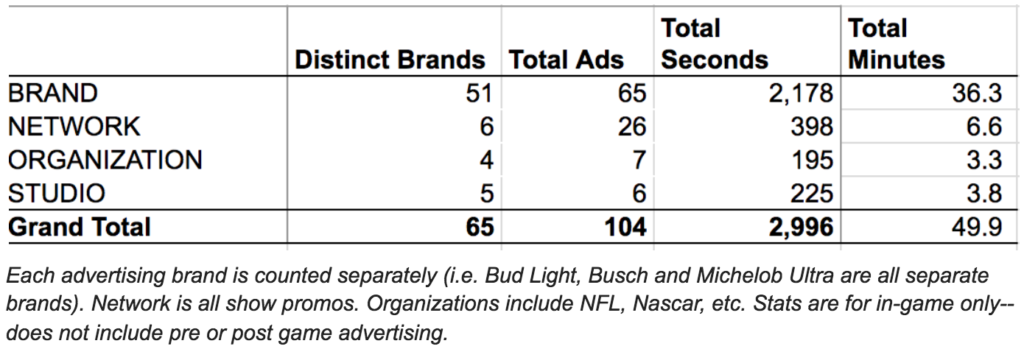How Super Bowl Advertisers Split Time and Tactic
If there is a single moment each year that illustrates the state of the TV industry it is the Super Bowl- or should I say the week before and after. As we are now entering official water cooler Monday let’s look at a quick recap of the creative horse race thanks to iSpot.tv, the attention analytics company that measures activity from 10+ million smart TVs and tracks responses to TV ads on social/digital platforms.It was a mix of old-fashioned brands, networks and studios competing for attention. First at a high level, here is a breakout of the types of advertisers and how much time went to each. 65 distinct brands ran 104 spots in 49 ad breaks for just under 3,000 seconds (49.9 minutes) of dedicated ad time. The advertisers generated Fox an estimated revenue of $509.6 million dollars on the in-game telecast (counts over-time but not post-game). The push for real-time marketing showed itself with Snickers stumbling through a live broadcast while Hyundai used same-day production to create a tear-jerking American story for its post-game A Better Super Bowl spot.Major industries from wireless and automakers to CPG brands battled for hearts and minds in plain view. Old fashioned brands like Mr. Clean embraced the second screen to troll other brands on Twitter, complimenting a strong creative Cleaner of Your Dreams, while Coke reprised a multi-cultural tone it struck in 2014. Google started the game by introducing its answer to Alexa.
The push for real-time marketing showed itself with Snickers stumbling through a live broadcast while Hyundai used same-day production to create a tear-jerking American story for its post-game A Better Super Bowl spot.Major industries from wireless and automakers to CPG brands battled for hearts and minds in plain view. Old fashioned brands like Mr. Clean embraced the second screen to troll other brands on Twitter, complimenting a strong creative Cleaner of Your Dreams, while Coke reprised a multi-cultural tone it struck in 2014. Google started the game by introducing its answer to Alexa.
And advertising showed, television is still a place to send a message. The darling to many, 84 Lumber - The Journey Begins premiered the beginning of an ad that drove viewers to an online-only finale that could be submitted as a short film on the plight of Mexican immigrants. In a more subtle but equally as cinematic tone, Budweiser struck its annual Super Bowl gold with Born the Hard Way, a story about the power of immigration in our modern American story. Audi - Daughter pre-game buzz generated steam on game day for its championing of equal pay for women.
Hats off to T-Mobile - #UnlimitedMoves for working the social math to pair Bieber, Gronk, and T.O. for a stunning estimated social reach nearing a half billion in a day’s time. Wix went all in early and held a strong position but that didn’t give much in the way of game day movement.
Melissa McCarthy deserves a hat tip for generating spark for Kia and her well received, awesomely timed SNL appearance.But really, many will argue it was Netflix - Stranger Things Season 2: 1984 that got the social web most worked up. And the data shows that to be the case.

